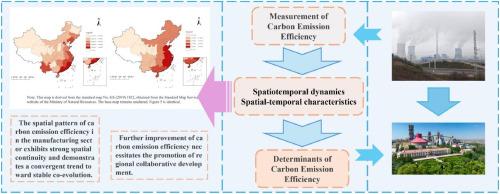中国制造业碳排放效率时空动态及影响因素综合分析
IF 8.4
2区 环境科学与生态学
Q1 ENVIRONMENTAL SCIENCES
引用次数: 0
摘要
制造业作为中国国民经济的支柱产业,其高碳排放的发展模式不仅是中国实现“双碳”目标的最大挑战,也严重威胁着全球生态安全和可持续发展。因此,提高碳排放效率(CEE)和减少碳排放是实现中国“双碳”目标和全球可持续发展的关键。本研究使用2005年至2022年中国30个省份的面板数据和中国排放账户和数据集(CEADS)提供的制造业二氧化碳排放当量。采用Super-EBM模型对中国制造业的碳排放效率进行了精确测算,该模型能够对极端效率进行深度分析。此外,采用前沿探索性时空数据分析研究中欧经济合作体系的时空演化,并采用空间计量模型评估中欧经济合作体系的影响因素。研究发现:(1)空间地理位置对中东欧经济合作体系具有显著影响。平均效率最高的省份是北京、广东和福建,其相对效率值均大于1。(2) CEECMS表现出较强的空间相关性,空间波动总体增加,但空间内聚性趋于稳定。(3)完善中东欧经济合作体系,需要注重以对外贸易为动力,以“成渝经济圈”模式推动区域协调发展,不断深化供给侧结构性改革。本文章由计算机程序翻译,如有差异,请以英文原文为准。

A comprehensive analysis of the spatiotemporal dynamics and determinants of carbon emission efficiency in China's manufacturing sector
As the mainstay of China's national economy, the development model of high carbon emissions in the manufacturing sector not only poses the greatest challenge to China's achievement of its “Dual Carbon” goals, but also significantly threatens global ecological security and sustainable development. Therefore, improving carbon emission efficiency (CEE) and reducing carbon emissions are key to realizing China's “Dual Carbon” goals and global sustainable development. This study uses panel data from 30 Chinese provinces from 2005 to 2022 and CO2 emissions equivalents from the manufacturing sector provided by China Emission Accounts and Datasets (CEADS). The Super-EBM model, which allows for in-depth analysis of extreme efficiency, is employed to accurately measure carbon emission efficiency of China's manufacturing sector (CEECMS). Additionally, frontier exploratory spatiotemporal data analysis is applied to investigate the spatiotemporal evolution of CEECMS, while spatial econometric models are used to assess the influencing factors of CEE. The study finds that: (1) The spatial geographical location has a significant impact on the CEECMS. The provinces with the highest average efficiency are Beijing, Guangdong, and Fujian, all of which have relative efficiency values greater than 1. (2) The CEECMS exhibits strong spatial correlation, with an overall increase in spatial fluctuations, but spatial cohesion tends to stabilize. (3) The improvement of CEECMS requires a focus on foreign trade as a driving force, promoting regional coordinated development based on the “Chengdu-Chongqing Economic Circle” model, and continuously deepening supply-side structural reforms.
求助全文
通过发布文献求助,成功后即可免费获取论文全文。
去求助
来源期刊

Journal of Environmental Management
环境科学-环境科学
CiteScore
13.70
自引率
5.70%
发文量
2477
审稿时长
84 days
期刊介绍:
The Journal of Environmental Management is a journal for the publication of peer reviewed, original research for all aspects of management and the managed use of the environment, both natural and man-made.Critical review articles are also welcome; submission of these is strongly encouraged.
 求助内容:
求助内容: 应助结果提醒方式:
应助结果提醒方式:


